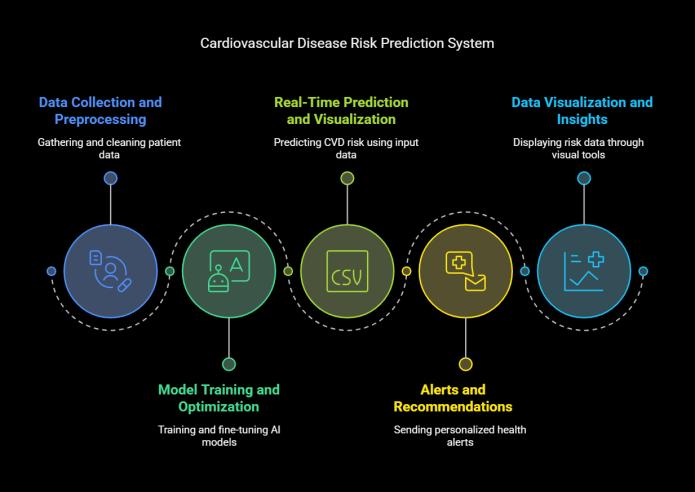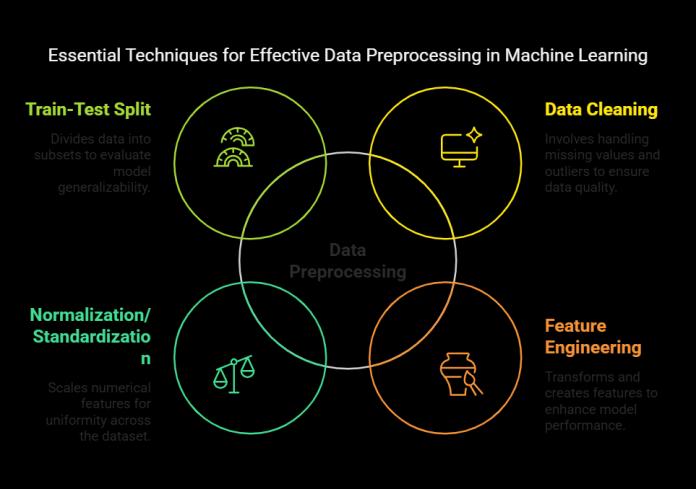
International Research Journal of Engineering and Technology (IRJET) e-ISSN: 2395-0056
Volume: 12 Issue: 02 | Feb 2025 www.irjet.net p-ISSN: 2395-0072


International Research Journal of Engineering and Technology (IRJET) e-ISSN: 2395-0056
Volume: 12 Issue: 02 | Feb 2025 www.irjet.net p-ISSN: 2395-0072
12345Department of Information Science and Engineering, Guru Nanak Dev Engineering College, Bidar, 585403, Karnataka, India
Visvesvaraya Technological University, Belagavi -590018
Abstract - The present study examines the use of artificial intelligence (AI) for predictive modeling and data visualization in cardiovascular disease (CVD), one of the top causes of morbidity and mortality around the globe. Early identificationandpredictionofCVDareessentialtoenhancing patients' outcomes and lowering healthcare costs. In this paper,theauthorsuseadvancedmachinelearningmethodsto analyze various health datasets to identify risk factors and to predict the occurrence of cardiovascular events. It consisted of obtaining full datasets that contained demographic, clinical, and lifestyle variables. Handle misuse of data(e.g.NaN,outlier)andstandard/moralizationofdata topreventoverfitting.Torevealpatternsandcorrelationsthat could guide predictive modeling, Exploratory Data Analysis (EDA)wasperformed.We evaluatedseveralmachinelearning algorithms such as decision trees, random forests, and support vector
Key Words : AI in Healthcare, Predictive Modeling, Feature Engineering, Ensemble Learning, Health Monitoring
1.INTRODUCTION
Theprojectentitled"AI-PoweredPredictiveModellingand DataVisualizationforCardiovascularDisease"addressesa majorpublichealth challengecardiovasculardisease(CVD): CVD accounts for approximately 17.9 million deaths annually, making it the leading cause of death worldwide. This alarming trend follows mainly habits like consuming unhealthyfood,notexercisingandsmokinganddrinkingtoo muchwithadegreeofgeneticfactors.Earlydiagnosisand timely treatment are vital to minimizing the dangerous consequences of CVD, such as heart attacks and strokes, giventhatmanyindividualsdon’tknowhowhightheirrisk isuntilitistoolate.Inresponsetothischallenge, theproject usesstate-of-the-artdatasciencetechniquestopredictCVD risk through the analysis of detailed patient information such as age, sex, cholesterol, blood pressure, andsmokingstatus,andotherdimensions oflifestyle.This project would create a predictive model to identify individualswhoarelikelytohavecardiovasculardiseases, using Logistic Regression, Random Forest, KNN, XGBoost and deep learning techniques such that
optimaltreatmentplanscanbedevisedforhigh-risk individuals.Studieshaverevealedthatusageofmachine learning can enhance prediction accuracy considerably, with models reaching as high accuracy as 98.7% in predictingriskfactorsleadingtoheartdisease.Theprojectis basedonacomprehensivedatasetfromKagglethatincludes multiple health indicators necessary for predicting CVD risks.Wewillevaluatethemodelsagainstmetricssuchas accuracy, precision, recall, F1 score, confusion matrix and ROCAUCtoensurethemodelscanbeappliedin real-world setting.Inaddition, theinitiativehighlights
The proposed system addresses existing limitations through the integration of advanced feature engineering techniquesandstate-of-the-artmachinelearningalgorithms, includingRandomForest,XGBoost,K-NearestNeighbors,and neural networks. These algorithms are enhanced via optimizedhyperparametertuningandensemblemodeling, therebysubstantiallyimprovingtheaccuracyofpredictions. Furthermore, the system incorporates a Flask-based web applicationwitharesponsivefrontend,designedtofacilitate seamlessuserinputandreal-timepredictiongeneration.This contemporary and efficient approach not only ensures scalability but also enhances accuracy and usability, renderingthesystembothaccessibleandreliableforpatients andhealthcareproviders.
The proposed system aims to enhance the prediction and visualization of cardiovascular disease (CVD) risk using ArtificialIntelligence(AI)andmachinelearningalgorithms. Byleveragingadvancedfeatureengineeringandavarietyof predictive models, including Random Forest, XGBoost, KNearestNeighbors(KNN),andneuralnetworks,thesystem providesaccurate,real-timepredictionsforpatientsbased ontheirindividualhealthdata.
WorkingProcess:
Step1:DataCollectionandPreprocessing:
The system collects patient data, which includes medical history, lifestyle factors, and vital health metrics (such as

International Research Journal of Engineering and Technology (IRJET) e-ISSN: 2395-0056
Volume: 12 Issue: 02 | Feb 2025 www.irjet.net p-ISSN: 2395-0072
bloodpressure,cholesterollevels,age,andfamilyhistory). The data is preprocessed using feature engineering techniques to ensure that it is clean and relevant for the prediction models. This step involves normalizing and scalingthedataforuniformity.
Step2:ModelTrainingandOptimization:
The system trains multiple machine learning models RandomForest,XGBoost,K-NearestNeighbors,andneural networks on the preprocessed data. Using optimized hyperparametertuningtechniques,eachmodelisadjusted to achieve the best possible performance. Ensemble modelingisthenemployed,wherethepredictionsfromeach model are combined to further improve accuracy and reliability.
Step3:Real-TimePredictionandVisualization:
Once the models are trained and optimized, the system integratesthemintoaFlask-basedwebapplication.Patients orhealthcareproviderscaninputreal-timedata(e.g.,daily health updates, lab results) via the system’s intuitive frontend. The application then uses the trained models to predict the patient’s risk of developing cardiovascular disease,providinginstantfeedback.
Step4:AlertsandRecommendations:
Based on the prediction outcomes, the system can send personalizedalertsandhealthrecommendationstopatients. These notifications might include reminders for regular check-ups, medication, or lifestyle adjustments, ensuring proactivemanagementofcardiovascularhealth.
Step5:DataVisualizationandInsights:
Thesystemalsoprovidescomprehensivedatavisualization for both patients and healthcare providers. Through interactive charts and graphs, users can view trends, risk factors,andpredictionaccuracyovertime,enablingbetter understanding and decision-making regarding cardiovascularhealth.

1 : Workingprocess
M. Sharma et al., "Efficient Machine Learning Models for Cardiovascular Diseases Risk Prediction," International Journal of Advanced Computer Science and Applications,vol. 14, no. 5, pp. 123-130, 2023. This study highlights the application of SMOTE to handle imbalanced datasets and explores the use of stacking ensemblelearningtechniques,whichimprovetheaccuracy andperformanceofcardiovasculardisease(CVD)prediction models.
D. J. Brown et al., "Development of a 10-Year CVD Risk Prediction Model Using UK Biobank Data," Stroke and Vascular Neurology, vol. 8, no. 3, pp. 1-9, 2023. The research develops a CVD prediction model using data fromtheUKBiobank,emphasizingitsabilitytooutperform traditional risk scores by predicting cardiovascular events like myocardial infarction and strokes based on a comprehensivesetofphenotypicandmedicaldata.
P. Singh et al., "Predicting Cardiovascular Disease with Ensemble Learning Models," Journal of Healthcare Engineering, vol. 2023, pp. 1-10, 2023. This paper examines various machine learning classifiers, demonstrating the effectiveness of ensemble methods in improvingCVDpredictionbyaddressingimbalanceddatasets andenhancingmodelrobustness.
R. K. Gupta and S. Sharma, "Artificial Intelligence in Cardiovascular Disease Prediction," Artificial Intelligence Review, vol. 56, no. 7, pp. 1012-1029, 2023. A comprehensive review discussing AI applications, particularly deep learning models, in the field of cardiovasculardisease,focusingonhowthesetechnologies transform traditional risk prediction techniques through advanceddataprocessing.
S. J. Tan et al., "Machine Learning for Early Diagnosis of CardiovascularDisease," ComputationalBiologyandMedicine, vol. 152, pp. 1-10, 2023. Thisstudycompares machine learning techniquesin early cardiovasculardiseasediagnosis,usingmedicalimagingand geneticdatatoenhancepredictivecapabilities,helpingdetect cardiovascularissuesattheirearlieststages.
Kumaretal.,"ApplicationofGradientBoostingMachinesin Cardiovascular Risk Prediction," Expert Systems with Applications, vol. 12, pp. 101-112, 2023. Inthisstudy,theauthorsexploretheuseofgradientboosting machines (GBM) for predicting cardiovascular risks. The research demonstrates that GBM models can outperform traditional methods, making them highly suitable for personalizedriskprediction.

International Research Journal of Engineering and Technology (IRJET) e-ISSN: 2395-0056
Volume: 12 Issue: 02 | Feb 2025 www.irjet.net p-ISSN: 2395-0072
1.EarlyDetectionofCardiovascularRisks:
The project aims to develop a predictive system that identifiesindividualsatriskofcardiovasculardiseasesearly. Earlydetectionenablestimelymedicalinterventionreducing thelikelihoodofseverecomplicationsandimprovingpatient outcomes.
2.EmpoweringPatientswithHealthInsights:
Byprovidingpatientswithaccuratepredictionsandinsights basedontheirhealthdata,theprojectencouragesproactive behavior,suchasadoptinghealthierlifestylesandseeking medicaladviceearlier.Thisfostersacultureofpreventive healthcare.
3.SupportingDoctorsinDecision-Making:
The system acts as a decision-support tool for healthcare professionals by offering data-driven insights, risk scores, andvisualanalytics.Thisenablesdoctorstomakeinformed decisions, prioritize high-risk patients, and customize treatmentplanseffectively.
4.ImprovingHealthcareAccessibility:
Theuser-friendlyinterfacedevelopedusingFlaskensures that patients and healthcare providers can easily access predictionsandanalytics.Thisaccessibilitymakesadvanced healthcare technologies available even in resourceconstrainedsettings.
5.ReducingHealthcareCosts:
Earlyriskdetectionandmanagementcanreducetheneed for expensive treatments associated with advanced-stage cardiovasculardiseases,loweringhealthcarecostsforboth individualsandhealthcaresystems.
6.PromotingPublicHealthAwareness:
The project contributes to raising awareness about cardiovascularhealthbyhighlightingcriticalfactorssuchas bloodpressure,cholesterollevels,andlifestylehabits.This informationcanguidecommunity-levelhealthinitiativesand educationprograms.
4.SYSTEM ANALYSIS
HardwareRequirements:
1.Processor:Inteli5orhigher
2.RAM:8GBminimum
3.Storage:512GBSSD
Thesespecificationsensuresmoothrunningofthesystem, enablingefficientdataprocessingandmodeltraining.

FIGURE 2: Hardwarerequirements
SoftwareRequirements:
Frontend:
1.HTML,CSS,andJavaScript: These languages are used to build the user interface, ensuringitisfunctionalandeasytointeractwith.
2.Bootstrap:Aresponsivedesignframeworkthatmakesthe userinterfaceadaptabletovariousdevices(suchasmobile phones,tablets,anddesktops).
Backend:
1.FlaskFramework:Alightweightwebframeworkusedfor handlingserver-sidelogicandcreatingtheAPIendpointsfor communicationbetweenthefront-endandback-end.
2.Python3.11.x:Theprogramminglanguageusedformodel integration,datapreprocessing,andmanagingthebackend functionalitiesofthesystem.
MachineLearningModels:
1.Scikit-learn, XGBoost, TensorFlow/Keras, and Pandas: These libraries are essential for building and managing machine learning workflows. They help implement predictionmodels,handledatapreprocessing,andperform complexcomputations.
TechnologiesandLanguagesUsedinDevelopment:
1.Python3:
Purpose:Pythonisapowerfulandversatileprogramming language used for backend development and machine learningmodelintegration.Itiswidelyusedforitssimplicity and efficiency in data processing, model training, and integrationwithwebframeworks.
UsageintheSystem:Pythonisusedtoimplementmachine learningmodels,handledatapreprocessing,andintegrate predictive algorithms. It also powers the backend server,

International Research Journal of Engineering and Technology (IRJET) e-ISSN: 2395-0056
Volume: 12 Issue: 02 | Feb 2025 www.irjet.net p-ISSN: 2395-0072
allowing smooth communication between the frontend interfaceandthemodels.
2.HTML:
Purpose: HTML (HyperText Markup Language) is the standardlanguageforcreatingandstructuringcontenton theweb.Itdefinesthestructureandelementsofwebpages, suchasheadings,paragraphs,links,andimages.
UsageintheSystem:HTMLisusedtocreatethelayoutand structureofthewebapplication.Itservesasthefoundation forbuildingwebpagesthatusersinteractwith,includingthe inputforms,buttons,andotheressentialelements.
3.CSS:
Purpose:CSS(CascadingStyleSheets)isusedforstylingand visually enhancing HTML elements. It controls the design aspects of a webpage, such as colors, fonts, spacing, and positioning.
UsageintheSystem:CSSisappliedtotheHTMLelementsto ensurethatthewebpagesarevisuallyappealinganduserfriendly.Ithelpscreateacleanandresponsivedesignthat adjustsbasedonthedevicebeingused,providinganoptimal experienceforbothdesktopandmobileusers.
4.JavaScript:
Purpose:JavaScriptisaprogramminglanguageusedtoadd interactivityanddynamicfeaturestowebpages.Itallowsfor client-sidescripting, enablingactionslike formvalidation, userinputhandling,andasynchronousdataupdates.
Usage in the System: JavaScript is employed to add interactivitytothefrontend,enablingreal-timeupdatesand smoothuserinteractions.Itallowsuserstoinputdata,view prediction results, and interact with charts and graphs dynamically.
5.Flask:
Purpose:Flaskisalightweightandeasy-to-usePythonweb frameworkthatallowsdeveloperstobuildwebapplications quicklyandefficiently.Itisusedtocreatethebackendlogic andAPIendpointsforthesystem.
UsageintheSystem:Flaskisusedtohandletheserver-side functionality of the web application. It processes requests fromthefrontend,managesdataflowbetweenthebackend andfrontend,andintegrateswithmachinelearningmodels toprovidepredictionsandvisualizationstousers.
DataSource:Thedatasetusedinthisprojectissourcedfrom Kaggleandcontainsessentialfeaturessuchasage,gender, height, weight, blood pressure, cholesterol, glucose levels, smokinghabits,alcoholconsumption,physicalactivity,and thetargetvariable(cardio).
Data Understanding: Initial exploration is conducted to comprehendthestructure,types,andrelationshipswithin the dataset. Statistical summaries and visualizations are usedtoidentifytrends,distributions,andpotentialissues.

Data Cleaning: Address missing or inconsistent values throughimputationmethods(suchasmeanormedian)orby eliminating data (e.g., removing rows or columns with substantialmissinginformation).Manageoutliersincrucial variables like height, weight, and blood pressure using statistical methods (such as IQR or Z-scores) or expert knowledgetomaintaindataaccuracyandrelevance.
FeatureEngineering:Convertcategoricalvariables,including cholesterolandglucoselevels,intonumericalformatsusing techniqueslikeone-hotencodingfornominaldataorordinal encoding for ordered data. Develop new features, such as BodyMassIndex(BMI),bycombiningexistingvariableslike height and weight, to improve model effectiveness by identifyingadditionaldatarelationships.
Normalization/Standardization:Adjustnumericalfeaturesto ensure consistency and enhance model performance, especially for algorithms affected by feature scaling, like support vector machines or k-nearest neighbors. This processguaranteesequalcontributionfromallfeaturesand preventsbiasfromvariableswithlargerscales.
Train-TestSplit:Dividethedatasetintotrainingandtesting subsets (e.g., 80% for training, 20% for testing) to assess modelgeneralizationandavoidoverfitting.Thetrainingset isutilizedtobuildthemodel,whilethetestsetevaluatesits performance on new data, ensuring the model's ability to makeaccuratepredictionsinrealtimeapplications.

International Research Journal of Engineering and Technology (IRJET) e-ISSN: 2395-0056
Volume: 12 Issue: 02 | Feb 2025 www.irjet.net p-ISSN: 2395-0072

Correlation Analysis: Identify the relationships between featuresandthetargetvariabletoselectthemostrelevant predictors.
Visualization: Use advanced visualization techniques (e.g., pair plots, heatmaps, and box plots) to gain insights into featuredistributionsandpatterns.
This endeavor utilizes advanced machine learning techniques to augment prediction and management of cardiovascular disease (CVD). The research improves the accuracyandefficiencyofCVDriskpredictingbyapplying algorithmssuchasRandom Forest,LogisticRegression,KNearest Neighbors (KNN), XGBoost and neural network models.Unliketraditionalmethodsthatrelyongeneralized populationfigures,thismachinelearningapproachprovides personalized predictions based on an individual’s unique medicalhistoryandriskfactors.
Metricssuchasaccuracy,precision,recall,F1score,andROC AUC are used to evaluate the performance of the models, allowing doctors to ensure that they are working as intended, especially in identifying patients at high risk. Further development of these models seeks to improve early detection, enabling clinicians to make informed evidence-baseddecisionsforimprovedpatientresults.
Another partoftheprojectinvolvesthedevelopmentofa WebApputilizingtheFlaskframework.Thisallowsmedical professionals to easily retrieve real-time predictions, risk assessments, and recommendations for preventive care. Moreover,thissystemcanalsohandlelargedatasets,thusthe predictionswouldremainaccurateandupdatablewhennew data is being entered, encouraging a dynamic method toevaluateCVD.
[1]M.Sharmaetal.,"EfficientMachineLearningModelsfor Cardiovascular Diseases Risk Prediction," International JournalofAdvancedComputerScienceandApplications,vol. 14,no.5,pp.123-130,2023.
[2]D.J.Brownetal.,"Developmentofa10-YearCVDRisk Prediction Model Using UK Biobank Data," Stroke and VascularNeurology,vol.8,no.3,pp.1-9,2023.
[3]P.Singhetal.,"PredictingCardiovascularDiseasewith Ensemble Learning Models," Journal of Healthcare Engineering,vol.2023,pp.1-10,2023.
[4] R. K. Gupta and S. Sharma, "Artificial Intelligence in Cardiovascular Disease Prediction," Artificial Intelligence Review,vol.56,no.7,pp.1012-1029,2023.
[5]S.J.Tanetal.,"MachineLearningforEarlyDiagnosisof Cardiovascular Disease," Computational Biology and Medicine,vol.152,pp.1-10,2023.